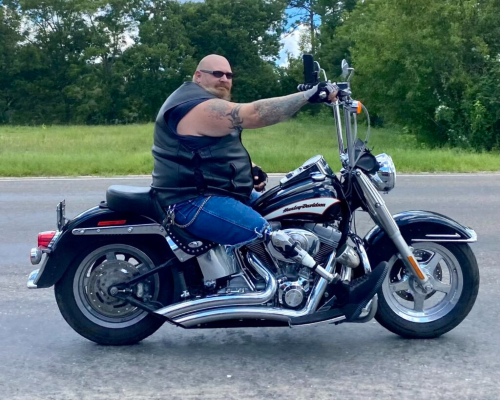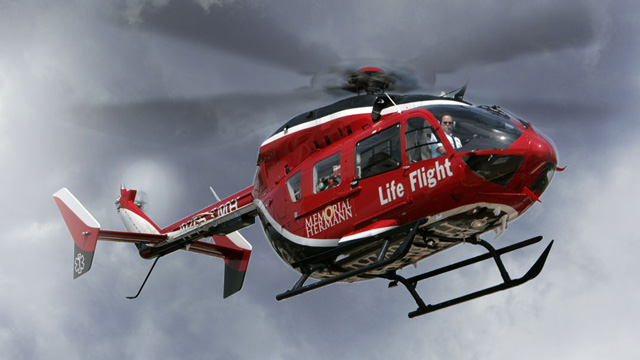
“I don’t remember flying over the top of the car,” he says. “But I remember hitting the ground, square on my chest. It sucked the wind out of me. I landed in the bottom of a ditch at the side of the road, and I remember lying there, looking at my leg, and thinking, ‘My leg is trashed.’ It was pretty nasty.”
The impact of the crash had broken his femur in half. He didn’t know that at the time, but he could tell he’d lost a lot of blood. As soon as the paramedics arrived, they called Memorial Hermann Life Flight®. Craft remembers looking out the helicopter window as it lifted off and telling the Life Flight nurse that he was tired. The next thing he recalls is waking up in a surgical ICU bed at the Red Duke Trauma Institute at Memorial Hermann-Texas Medical Center, one of the busiest Level I trauma centers in the nation.
“The doctor told me I had two choices,” he says. “He could try to save the leg, but I’d probably always have pain and limited mobility because my foot would be turned out. Or he could cut the leg off below the knee and I could get a prosthesis and get back to my normal life.”
Craft, now 42, opted for amputation, but it wasn’t an easy fix. Ultimately, he spent five weeks in the hospital and underwent 15 surgeries. It was a long road back to his normal life. On National Trauma Survivors Day, he is reflecting on his journey and offering hope to other survivors, including the more than 120,000 trauma patients treated annually at Memorial Hermann hospitals.
Memorial Hermann offers a variety of resources to help survivors of traumatic injury, including virtual support groups and an online recovery course.
“It’s hard, but it’s very much a mental game,” Craft says. “It’s natural to focus on what you’ve lost, but a better focus is: What can I accomplish now? You have to set goals for yourself, and you have to figure out what makes you smile and makes you happy.”
At first, he wasn’t smiling. “I had a really hard time during the first surgery. I woke up from the anesthesia screaming and swinging,” he says. “They gave me more anesthesia and then I didn’t come out of it for more than 12 hours. They weren’t sure if I would ever regain consciousness.”
Craft’s injury was so severe that it took the surgeon hours just to pick the bone shards out of his knee. “It looked like a grenade had exploded on my kneecap,” Craft says. “And all that shattered bone caused an infection.”
Lying in stagnant ditchwater with an open wound hadn’t helped. Craft ended up with sepsis and had to be treated with intravenous antibiotics and a wound VAC, which uses negative pressure to help heal infected wounds.
“That wound VAC was something else,” he says. “That was the worst part.”
Once the wound healed and Craft received his prosthetic leg, things started to get better. He did physical therapy at TIRR Memorial Hermann twice a week and made good progress. “My therapist didn’t cut me any slack. If it hadn’t been for them, it would probably be a different story,” he says.
He’s glad he opted for amputation, because he can still do the activities that bring him joy — including riding his motorcycle. “I’d much rather wear a prosthesis and do what I was doing before than keep my leg and have to give up the things I love,” he says. “I ride four-wheelers and play in the mud. I’m still doing the same things I was doing, just not as fast.”
But during the early days of his recovery, he wasn’t sure what his future would hold. Because he was unable to work for months, he fell behind on bills, and he and his wife lost their home, their cars and his motorcycle.
“I went through depression pretty bad,” he says. “I actually got to a point where I didn’t think I’d ever be worth anything again. In those first few months, when you’re stuck in a wheelchair, you’re dependent on other people to do everything for you. I was fortunate enough that I could go the bathroom on my own. Some people don’t have that luxury, and that takes a huge mental toll. You look at yourself and think, ‘What am I supposed to do?’”
Craft also suffered for years from post-traumatic stress disorder. He would wake up in the middle of the night reliving the crash, feeling the crunch of his body hitting the ground and the wind being knocked out of him. That’s gotten better. He still feels phantom pain occasionally; however, and at times it can be debilitating.
“It feels like my toes are curled up in my shoes. On bad days, it feels like I stepped on an ice pick,” he says. “That’s part of the difference from losing a limb to trauma, as opposed to something like diabetes. When you experience trauma like that, there’s a piece of it that embeds in the memory. Your brain holds onto it. My toes were actually broken in my boots the day of the accident, so I can still feel that.”
But his outlook is bright these days. He and his wife started over: they have a new home and are out of debt. He’s back at work as a commercial manager for a supply company. And he’s still doing the things he loves, including riding his Harley.
In November, while riding, he collided with a deer on the same county road where he had his first accident. Once again, he was flown via Life Flight to Memorial Hermann-TMC, this time with a fractured humerus bone that had to be repaired with titanium plates.
So, would he ever consider trading in his motorcycle, given the dangers he’s encountered?
“I can’t do it. I can’t give it up,” he says. “I’d be absolutely miserable if I wasn’t riding. It’s not just a hobby; it’s a lifestyle for me. That’s part of the key to recovery. You can’t sit around and mope. You have to have goals. And you have to have fun.”

Donate to Red Duke Trauma Institute
Please consider making a donation to the Red Duke Trauma Institute at Memorial Hermann-Texas Medical Center. No matter which area of the mission you support, your gift will make a lasting impact on patients and their families.
Donate Now